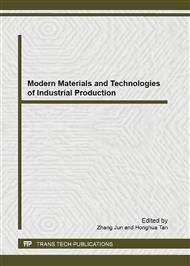p.146
p.152
p.157
p.163
p.171
p.177
p.181
p.186
p.192
Corrosion Characterization of High Moment Magnetic Material Coated with Diamond-Like Carbon
Abstract:
In order to increase data storage density of hard drive, DLC overcoat thickness was decreased to allow read/write head to come closer to magnetic alloy of the disk, andwith maintaining the main purpose of the overcoat to provide good corrosion and mechanical protection for the underlying magnetic recording film under unfavorably environmental conditions and occasional reactions. Base on that the edges of topography will be weak point for deposition films cause of shadow effect during the process, its hard that deposition atomic will stay at the concave and convex of topography. DLC coverage performance at the edge of 3D topography becomes high sensitive with limited DLC films thickness. Currently the 3D profile of magnetic material that needs to protect with DLC, is about 2 nanometers with subnanometres DLC thickness. The enormous of data shrew corrosion pattern was usually happened at the edge of topography. Thus, the accelerated test or indirect methodology was applied for DLC integrity. This investigation was explore the methodology to verify the weakness of DLC films especially at the topography edges which is difficult for any direct metrology tools can pursue. With pore resistance, which related to the film structure, the electrochemical impedance indicated that DLC/Si3N4 is a suitable choice to against corrosion. However topography surface influence to DLC coverage. Controllable surface for DLC deposition also needed well defined. Two types of step height was created as 1 nm and 2 nm on (100) silicon substrate. The 20Å DLC film thickness was deposited on the silicon substrate with promised technique, Filtered Cathodic Vacuum Arch (FCVA). After this process the aluminum (Al) was deposited on the surface of DLC film by using evaporation technique. The silicon substrate was driven to Al surface thro pin holes on the DLC film at 577OC. To detect the pin holes on the DLC film, the aluminum layer was removed by using wet etch chemical process. The SEM image indicates that the square pitting at the edge of DLC film obtained for 2nm step height was around 2nm depth. The latest experiment in this investigation to characterize 2.3 T magnetic moment material degradation with DLC/Si3N4 coating, was performed with electrochemical impedance spectroscopy and AFM. The material with DLC overcoat after exposed to H2SO4 for 30 min, polarization resistance was increased for 2 times from uncoated material. Alternative charge transfer capacitance was reduced as desirable charge current.
Info:
Periodical:
Pages:
171-176
Citation:
Online since:
September 2013
Keywords:
Price:
Сopyright:
© 2013 Trans Tech Publications Ltd. All Rights Reserved
Share:
Citation:


